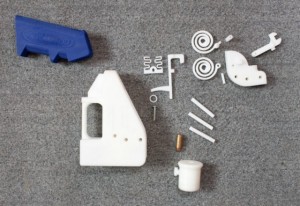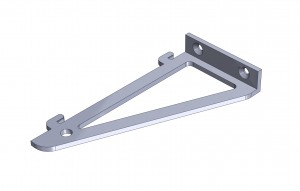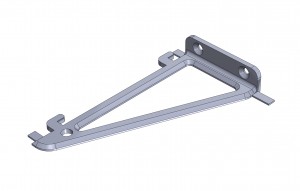Who would have thought…a 3D printer that uses yarn? It uses a needle to piece and entangle the newly placed yarn with the material below, so you end up with more of a ‘lump’ than woven fabric. But, pretty cool stuff. Check out the video below to see it in action.
Rapid prototyping for sheetmetal forms
Prototyping formed sheetmetal parts has never been fast…until now. Rather than building the dies to actually form the part, Ford has developed a computer-controlled system that can do this with just the 3D CAD data. Pretty cool!
(via Gizmodo)
3D printed gun
 With all the advances in 3D printing, it was inevitable that someone, someday, would create a 3D printed gun…and that day is here. The only non-plastic parts are the firing pin, and the bullet. Everything else is plastic, printed on a Stratasys Dimension SST 3D printer in ABS…a step above the hobbyist grade 3D printers like the Cube.
With all the advances in 3D printing, it was inevitable that someone, someday, would create a 3D printed gun…and that day is here. The only non-plastic parts are the firing pin, and the bullet. Everything else is plastic, printed on a Stratasys Dimension SST 3D printer in ABS…a step above the hobbyist grade 3D printers like the Cube.
As far as firearms go, this one is pretty crude – it’s a single shot device which must be manually loaded, and a test with a larger caliber bullet resulted in destruction of the gun (the successful test used a .380 caliber round).
So, this is very much an immature product, but represents a huge milestone for the technology. There are those who believe that our species can create amazing technology and regulate it to the point where it is safe for society, but the reality is that technology can be used for both good and bad, and attempts to regulate that are eventually futile.
If you want to download the models yourself, head to DefCAD. I wouldn’t recommend it though…this is a marginal design and really more of a proof of concept…be careful. Note that in the test firings, a string was used to actuate the trigger.
Read more at ExtremeTech.
Computer Assisted Design
All this 3D printing has reminded me of perhaps my favorite music video of all time…Computer Assisted Design by They Might Be Giants. It’s really a combination of Computer Assisted Design and Computer Assisted Manufacturing…but hey, for the target audience (younger than me!), it’s great.
One more thing – PLA plastic, one of the options for use in my 3D printer, is compostable!
Part Design for 3D Printing on a Cube
 I’ve been really enjoying my Cube printer, but it has not been without its learning curve. Like any part design, you need to design the part with the manufacturing process in mind, and I’m learning quite a bit about extruded filament part production.
I’ve been really enjoying my Cube printer, but it has not been without its learning curve. Like any part design, you need to design the part with the manufacturing process in mind, and I’m learning quite a bit about extruded filament part production.
One issue is that large parts with thick sections tend to warp. The Cube software provides an option for a raft – basically a lattice of thin lines laid down first, providing a stable bed upon which to build the part – but this greatly increases the post-processing time. Namely, you need to scrape or sand off the raft. It’s not a huge deal but does waste material and time.
Consider the bracket design shown above. It’s simple enough, with a uniform cross section and was designed to be printable without needing supports (thin webs of material to support overhangs and such). However, when printing, this part would warp and curl, forcing me to abort the print.
To address this, I did a few things. First, I added thin tabs at the corners to help hold those down. The principle is similar to the raft, but much easier to clean up (just cut them off – very quick and clean). This alone did not produce a repeatable, printable part. So, I added large chamfers at all edges, to reduce the part thickness and reduce warping. This did the trick, and I was able to repeatedly print this (I’m using ABS, for what it’s worth). Here’s what the final design looks like:
As I learn more, I’m just not seeing how this technology is ready for mainstream home use like some articles seem to suggest. You need to be a tinkerer and know your way around CAD to get parts that are really going to do what you want. For that type of person though, this printer is fantastic! I’ve been able to iterate prototype parts much quicker than before and am producing better designs, faster.


